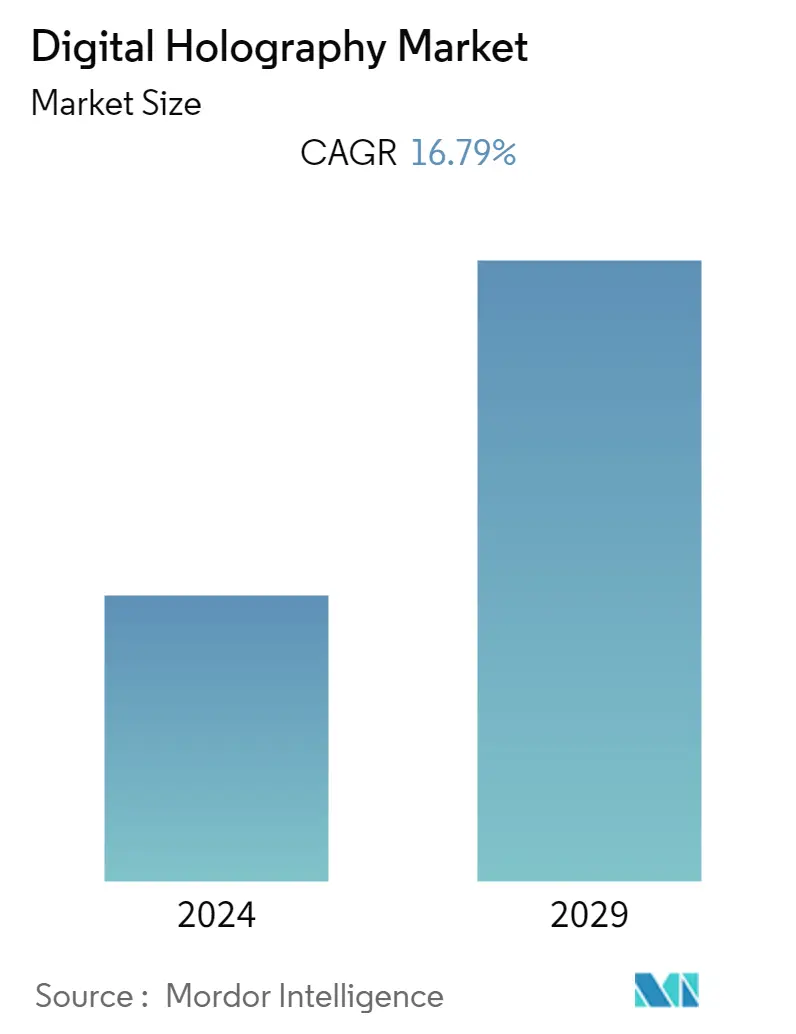
| Study Period | 2019 - 2029 |
| Base Year For Estimation | 2023 |
| Forecast Data Period | 2024 - 2029 |
| CAGR | 16.79 % |
| Fastest Growing Market | Asia Pacific |
| Largest Market | North America |
| Market Concentration | Low |
Major Players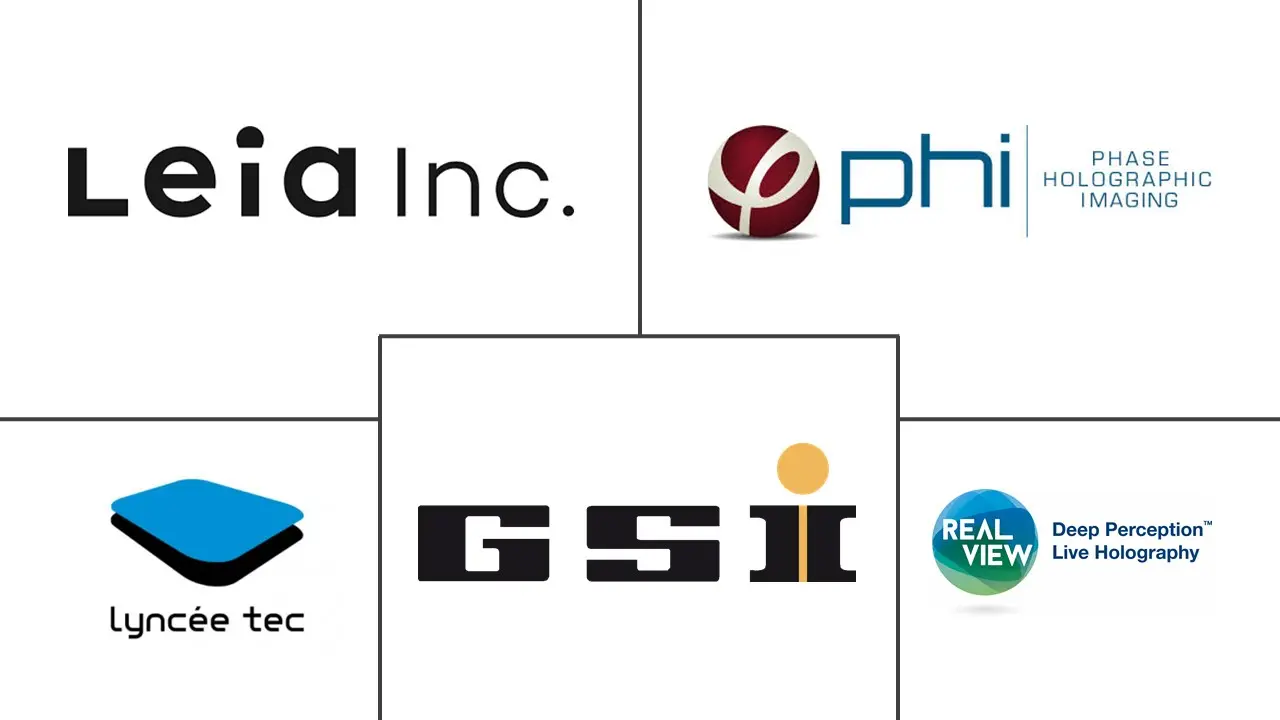
*Disclaimer: Major Players sorted in no particular order |
Digital Holography Market Analysis
The Digital Holography Market size is expected to grow from USD 4.92 billion in 2023 to USD 10.69 billion by 2028, at a CAGR of 16.79% during the forecast period (2023-2028).
Two waves are required to produce a hologram and simultaneously record quantitative phase and amplitude images in digital holography. Several application scenarios have demonstrated how this novel idea enables quick 3D imaging. Every industry, including real estate, healthcare, education, and retail, turns to the 3D world to get a more precise and accurate picture of their business models.
- Retailers can incorporate self-service kiosks where customers may engage with a holographic product, bringing an entirely new level of engagement that could ultimately result in greater sales to ensure a frictionless shopping experience. In Pennsylvania, Coen Markets opened two checkout-fee stores; with the aid of the Grabango app, customers may make payments without going through a checkout process.
- Holographic imaging technology boosts biomedical research, healthcare, life sciences, and medical education and training. To better prepare medical students, Cambridge University Hospitals (CHU) and the university's education faculty have introduced mixed reality. Students using Microsoft HoloLens mixed reality headsets can see each other in real-time while engaging with a multi-layered, medically accurate holographic patient thanks to an app that CUH and the university's faculty of education developed in collaboration with tech company GigXR.
- Adopting 3D holography from 2D involves significant expense due to the high cost of objective lenses and specialized digital imaging equipment requirements. Due to the higher computing costs associated with processing holograms, the approach also has a limited range of applications.
- Businesses became aware of the necessity of adopting the newest approaches during COVID-19 due to social estrangement, remote employment, and online education. This increased the need for AR and VR in numerous industries to provide users with a real-life experience. For gaming lovers, VividQ and Dispelix designed a holographic tech that can be used with AR headsets or smart glasses. Gamers can take part in immersive augmented reality experiences where digital content is displayed in the real environment for easy and comfortable interaction.
Digital Holography Market Trends
Digital Holographic Displays to Hold the Significant Market Share
- Customers' interest can be effectively drawn in by using digital signage. Holographic display technology will increase marketing effectiveness and let users enjoy content without headgear restrictions.
- According to a survey by Queppelin, there are 57.4 million active VR users in the US, and the AR-VR market is projected to reach USD 1.5 trillion. Immersive technology, such as virtual reality, is expected to impact the healthcare sector significantly.
- In June 2022, Looking Glass introduced the world's largest holographic display. The 65-inch, 8K-resolution screen is five times bigger than any previous 3D holo display and requires no special equipment to see the visuals. The new display is "group viewable," distinguishing it from several competing products that one person can only view at a time.
- In October 2022, an India-based startup PORTL, an Intelligent Home Mirror, announced plans to design cabinet-sized holographic displays in places that might be useful, like stores, meeting rooms, or even classrooms. One application for these PORTL EPIC devices is full-body video chatting, product browsing, and evaluation before a consumer decides to purchase.
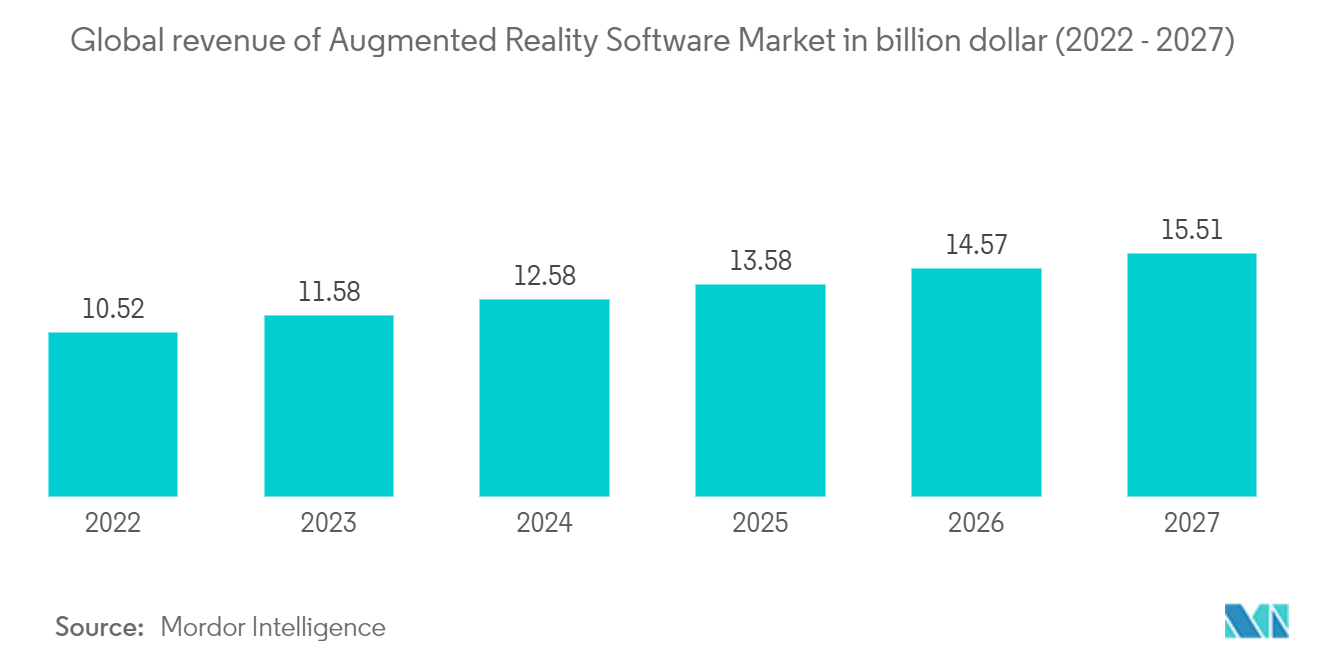
Asia-Pacific to Witness Significant Growth
- The adoption of digital technology has been the fastest in Asia-Pacific. The metaverse will become increasingly important as more nations build smart cities. Every industry, including real estate, healthcare, education, and retail, is turning to the 3D world to get a clearer and more accurate picture of their business models. For instance, Vizzio Technologies, based in Singapore, built a digital twin of the city of Singapore to give consumers a seamless 3D experience. A similar 3D map of Osaka and Tokyo was produced by the CAD Center in Japan, utilizing cutting-edge software to create immersive experiences.
- In January 2022, to make in-person buying safer, 7-Eleven Stores in Japan installed floating holographic displays that function without any physical contact. With the use of this Digi POS, a touchscreen interface will appear to be floating in midair in front of a customer while those in line behind them see nothing at all.
- In December 2022, footwear company Bata unveiled 3D OOH Billboards. This novel method of 3D outdoor advertising draws attention to the range of sneakers the company sells. The billboard makes use of an anamorphic image content generation method to provide content that appears in three dimensions and is visually appealing.
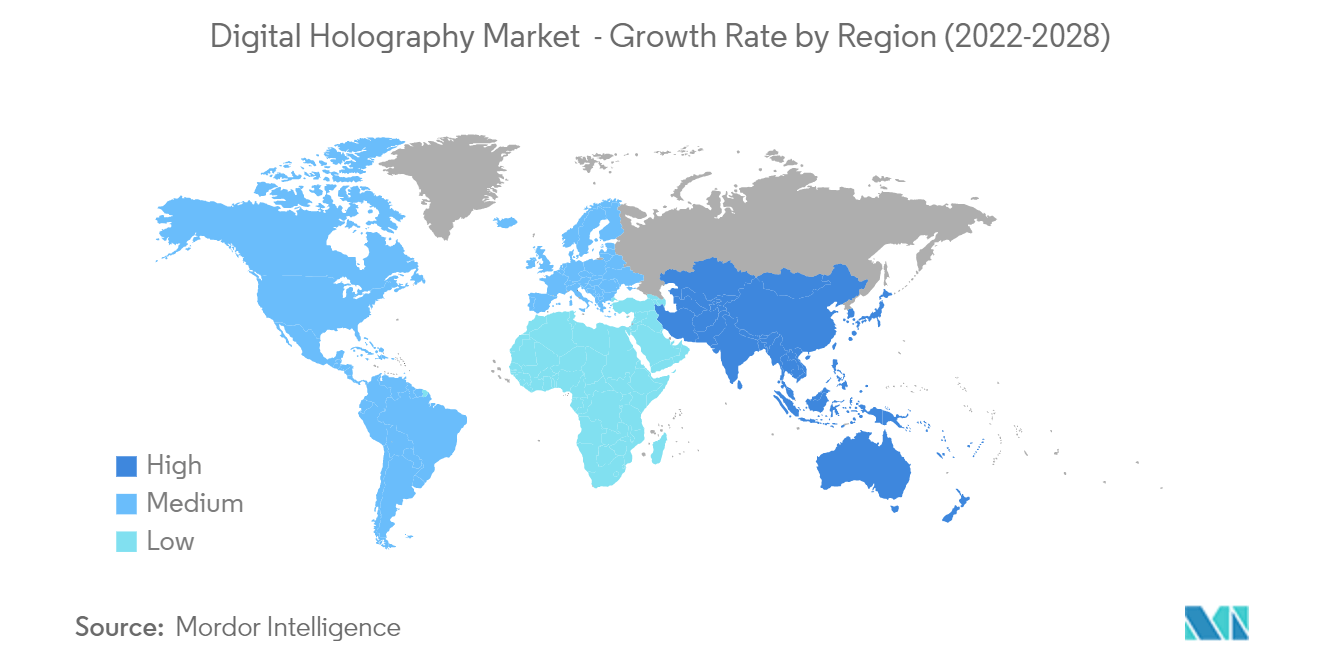
Digital Holography Industry Overview
Due to comparable portfolio offerings and the danger of alternatives, the digital holography market is highly fragmented and comprises multiple sizeable competitors. To maintain their competitive edge and grow their customer base and market share, the vendors regularly invest in R&D to improve their product lines, bring more product lines into practical applications, and expand their product lines.
In November 2022, Sam Walton, the founder of Walmart, was digitally recreated as a hologram by Proto, a provider of life-sized holographic communications solutions, in collaboration with StoryFile, the maker of an AI-powered conversational video platform. The hologram will eventually be on display in The Walmart Museum to inform visitors about the early history of Walmart, the company's core values, Walton's rules of business, and more.
In February 2023, the leading holographic company, Looking Glass, received funding from Accenture. Accenture will speed up the transition from 2D to 3D through this partnership. Looking Glass has built an end-to-end holographic platform with a selection of monitors that can display material in real-time 3D without the need for headsets or head-tracking.
Digital Holography Market Leaders
-
RealView Imaging Ltd.
-
Lyncee TEC SA
-
Phase Holographic Imaging AB
-
Geola Digital Uab
-
Leia Inc
- *Disclaimer: Major Players sorted in no particular order
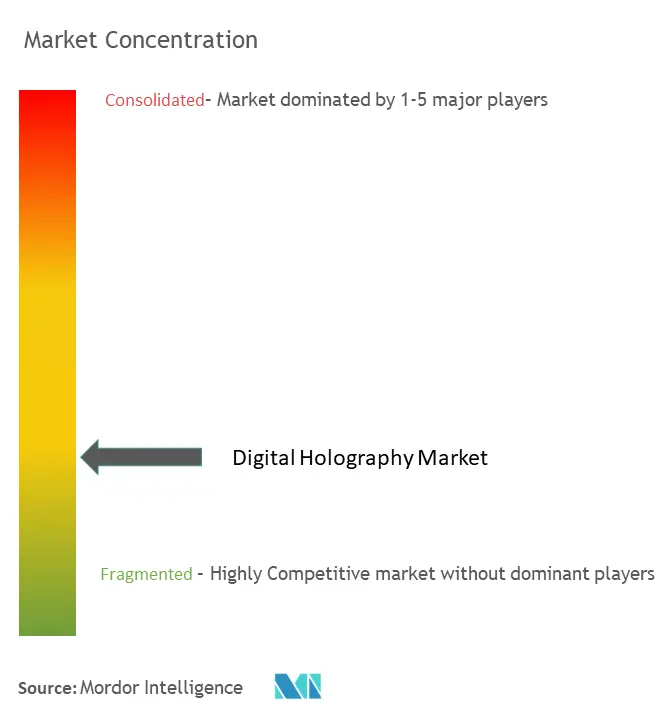
Digital Holography Market News
Jan 2023: ThirdEye, a pioneer in augmented reality, has added a fully integrated thermal solution to its lineup of smart glasses. This perfectly complements the human hologram image with an integrated thermal camera feed. Doctors can provide more accurate diagnoses and treatment recommendations through this technology by delivering real-time visual information during remote consultations.
Nov 2022: An integrated range of holographic, incredibly realistic, real-time 3D (RT3D) organ simulation models was released by GigXR and ANIMA RES. These models allow medical students to view the selected virtual organs at various stages of illness and disease, providing precise knowledge about organ function and disease progression.
Oct 2022: During (India Mobile Congress) IMC, Airtel and Nokia used holographic images to depict the cultural splendor of the Statue of Unity and the Kashi Vishwanath temple to highlight the advantages of the ultra-fast and low latency 5G network. These holograms replicated the original experience by providing an actual perspective of the structure and layout of these famous temples and landmarks. Immersive virtual travel is expected to help reshape the travel and tourism industry by allowing the general public to visit distant locales and historical landmarks from the comfort of their own homes.
Digital Holography Industry Segmentation
A wavefront diffracted from an object is captured using the holographic technique. By applying the theory of light diffraction, a hologram can be used to rebuild a three-dimensional (3D) image. An object's wavefront is recorded on a digital hologram using the process known as "Digital Holography," and then a computer is used to reconstruct both quantitative phase pictures and 3D images of the object.
The Digital Holography Market is Segmented by Offering (Hardware and Software), Application (Digital Holographic Displays, Digital Holographic Microscopy, and Holographic Telepresence), End-user Vertical (Medical, Aerospace and Defense, Commercial, Education, Automation, and Other End-user Verticals), and Geography. The market sizes and forecasts are provided in terms of value (USD) for all the above segments.
| Offering | Hardware (Beam Splitter, CCD Camera, Laser, and Others) | |
| Software | ||
| Application | Digital Holographic Displays | |
| Digital Holographic Microscopy | ||
| Holographic Telepresence | ||
| End-user Vertical | Medical | |
| Aerospace and Defense | ||
| Commercial | ||
| Education | ||
| Automation | ||
| Other End-user Verticals | ||
| Geography | North America | United States |
| Canada | ||
| Geography | Europe | Germany |
| United Kingdom | ||
| France | ||
| Rest of Europe | ||
| Geography | Asia-Pacific | India |
| China | ||
| Japan | ||
| Rest of Asia-Pacific | ||
| Geography | Latin America | Brazil |
| Argentina | ||
| Rest of Latin America | ||
| Geography | Middle-East and Africa | United Arab Emirates |
| Saudi Arabia | ||
| Rest of Middle-East and Africa |
Digital Holography Market Research FAQs
What is the current Digital Holography Market size?
The Digital Holography Market is projected to register a CAGR of 16.79% during the forecast period (2024-2029)
Who are the key players in Digital Holography Market?
RealView Imaging Ltd., Lyncee TEC SA, Phase Holographic Imaging AB, Geola Digital Uab and Leia Inc are the major companies operating in the Digital Holography Market.
Which is the fastest growing region in Digital Holography Market?
Asia Pacific is estimated to grow at the highest CAGR over the forecast period (2024-2029).
Which region has the biggest share in Digital Holography Market?
In 2024, the North America accounts for the largest market share in Digital Holography Market.
What years does this Digital Holography Market cover?
The report covers the Digital Holography Market historical market size for years: 2019, 2020, 2021, 2022 and 2023. The report also forecasts the Digital Holography Market size for years: 2024, 2025, 2026, 2027, 2028 and 2029.
Our Best Selling Reports
Digital Holography Industry Report
Statistics for the 2023 Digital Holography market share, size and revenue growth rate, created by Mordor Intelligence™ Industry Reports. Digital Holography analysis includes a market forecast outlook to 2029 and historical overview. Get a sample of this industry analysis as a free report PDF download.




